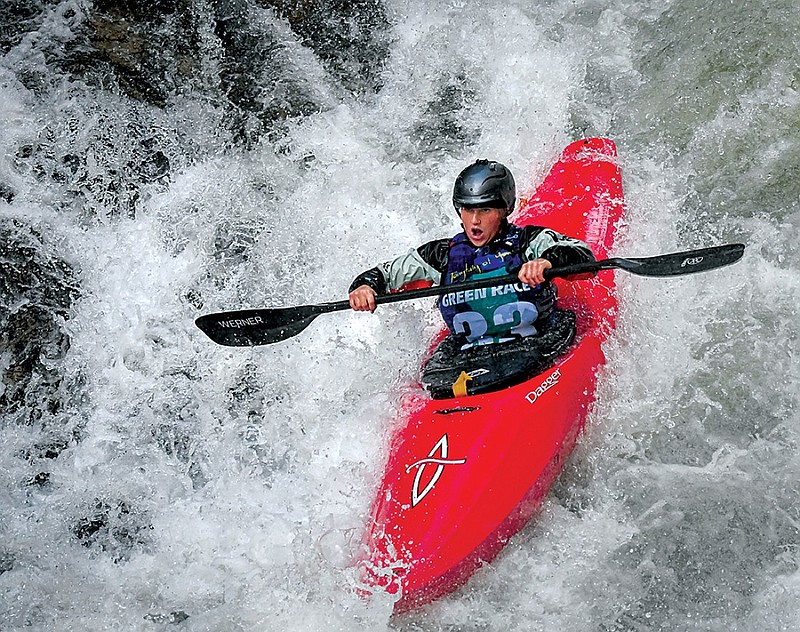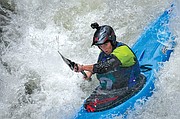Ask nearly any whitewater kayaker in the Southeast about their plans for the first Saturday in November, and the odds are good that their answer will involve the Green Race.
Billed as "The Greatest Show in all of Sports," the Green Race is a sporting event unlike any other, featuring big crashes, epic rescues and a tightknit community celebrating first-time racers alongside seasoned pros and some of the biggest names in the sport.
Plus, it's not often that the spectating is nearly as hazardous as the sport.
The Green Race takes place on a milelong section of the Green River Narrows, located about an hour south of Asheville, North Carolina. Whitewater rapids are classified on a scale from I-VI, with a Class I rapid being the easiest and a class VI rapid considered unrunnable.
The Green Race boasts a mix of class IV and V rapids, including the infamous Class V rapid called Gorilla.
Visually impressive and physically intimidating, Gorilla involves a tight sequence of moves, an 18-foot drop and little margin for error. Over the years it has dished out many beatings (and broken bones). In other words, it's for experts only, a sentiment echoed by the Green Race registration page: "We do not recommend participating in this event."
On race day, over a thousand spectators will brave an epic 3-mile hike (which includes a milelong section so steep ropes have been set to serve as handrails) to stand on the bank above Gorilla, cheering for clean lines and crashes alike. Because of its unpredictability and consequence, during the Green Race, a dedicated team of volunteers (led by longtime racer and former organizer Tommy Hilleke) provides safety for racers ensuring that those who crash in Gorilla do not wash into the next sequence of rapids.
The first Green Race took place in 1996, and it has continued ever since, though in 2020 spectators weren't allowed at the event due to the pandemic.
According to current race organizer John Grace, "Like all good things in life, the Green Race was an idea hatched after maybe one too many beers."
Leland Davis and Jason Hale were hitchhiking their shuttle on the Gauley River, a popular area for rafters and kayakers in West Virginia, when Hale pitched the idea of a race on the Green River Narrows. Davis offered to organize the event, saying, "[Hale] and I were both against entry fees back then. We wanted it to be accessible to every dirtbag."
The Green Race was free for the first 11 years, but now costs $65 which includes a race bib and entrance to the festival, and also covers the cost of digital RFID timing.
As the race grew in popularity, the crowd of spectators also grew. In 2003, Red Bull offered to sponsor the event, including the introduction of cash prizes for the winning racers -- but its event insurance would have required stringent crowd control measures, making it impossible for would-be spectators to see Gorilla. Ultimately, the organizers turned down Red Bull's offer, and the grassroots vibe of the race has continued into the present.
Photo Gallery
What to know about the Green Race, a whitewater event that’s nearly as hazardous for spectators as it is racers
About 150 paddlers compete each year. The race starts at high noon, and unlike many other paddling events, it does not include a qualifying round or different events. Instead, every racer -- no matter their experience -- races the same course on the same day. There is no prize money, just a stained glass trophy made by a local kayaker.
However, the community has its own ways of recognizing personal bests and achievements that do not involve a podium.
Those racers skilled enough to post a race time under five minutes are considered "Class V Certified," while many local returning racers place bets against their friends and fellow competitors about who will beat whom. Rumor has it that a few years ago, the loser of one of these bets ended up with a tattoo (of a gorilla, of course).
Green Racer Logan Kendricks says, "The shared cocktail of emotions -- ranging from anticipation and uncertainty to stoke and excitement -- create a special sense of community...the feeling of cheering others on as they accelerate off the start line, and the feeling when you are being cheered on by the safety crew and spectators alike."
This sense of community celebration is shared by Adriene Levknecht, who has won the Green Race a record-breaking twelve times. She says, "I look at the Green Race more like a holiday than a race day. I get to see almost all of my family and friends in one place while going fast down one of my favorite rivers. How could it not be the best day ever?"
For many racers and community members, the excitement of this year's Green Race will be tempered by sadness. One of the leading creators of the Green Race media team, Sarah Ruhlen, passed away earlier this year. True to form, the community has come together to honor her life, spirit and legacy by dedicating this year's Green Race to her.
The first Saturday of November is a day for cheering on friends and experiencing the strength, kindness and joy of the paddling community in one of the most magical places. It is also a day for going fast.
Want to go?
The 27th annual Green Race takes place on Nov. 5 at high noon. Learn more about "The Greatest Show in all of Sports" at greenrace.us.

